Randomized Double-Blind Placebo-Controlled Supplementation with Standardized Terminalia chebula Fruit Extracts Reduces Facial Sebum Excretion, Erythema, and Wrinkle Severity
Abstract
1. Introduction
2. Material and Methods
2.1. Materials
2.2. Study Design, Recruitment and Randomization
2.3. Inclusion and Exclusion Criteria
2.4. Facial Imaging, Measurements of the Biophysical Properties of the Skin
2.5. Statistical Analysis
3. Results
3.1. Sebum Excretion Rate
3.2. Facial Erythema
3.3. Facial Wrinkles
4. Discussion
5. Conclusions
Author Contributions
Funding
Institutional Review Board Statement
Informed Consent Statement
Data Availability Statement
Conflicts of Interest
References
- Jokar, A.; Masoomi, F.; Sadeghpour, O.; Tossi, M.N.; Hamedi, S. Potential therapeutic applications for Terminalia chebula in Iranian traditional medicine. J. Tradit. Chin. Med. 2016, 36, 250–254. [Google Scholar] [CrossRef] [PubMed]
- Rathinamoorthy, R.; Thilagavathi, G. Terminalia Chebula—Review on Pharmacological and Biochemical Studies. Int. J. PharmTech Res. 2014, 6, 97–116. [Google Scholar]
- Randhawa, M.; Meyer, T.; Sachdev, M.; Chaudhuri, R.K. Standardized Terminalia chebula Fruit Extract: A Natural Ingredient That Provides Long-Lasting Antioxidant Protection and Reverses Visible Signs of Pollution-Induced Skin Damage. Clin. Cosmet. Investig. Dermatol. 2021, 14, 1257–1269. [Google Scholar] [CrossRef] [PubMed]
- Yakaew, S.; Itsarasook, K.; Ngoenkam, J.; Jessadayannamaetha, A.; Viyoch, J.; Ungsurungsie, M. Ethanol extract of Terminalia chebula fruit protects against UVB-induced skin damage. Pharm. Biol. 2016, 54, 2701–2707. [Google Scholar] [CrossRef]
- Handler, M.; Adams-Woodford, A.; Ayres, P.; Giancola, G.; Diaz, I. Facial Aging Improvement Case Study Using a Novel Combination of Retinol, Niacinamide, and Terminalia Chebula. J. Drugs Dermatol. 2022, 21, 784–788. [Google Scholar] [CrossRef] [PubMed]
- Talapko, J.; Včev, A.; Meštrović, T.; Pustijanac, E.; Jukić, M.; Škrlec, I. Homeostasis and Dysbiosis of the Intestinal Microbiota: Comparing Hallmarks of a Healthy State with Changes in Inflammatory Bowel Disease. Microorganisms 2022, 10, 2405. [Google Scholar] [CrossRef] [PubMed]
- Effendi, R.; Anshory, M.; Kalim, H.; Dwiyana, R.F.; Suwarsa, O.; Pardo, L.M.; Nijsten, T.E.C.; Thio, H.B. Akkermansia muciniphila and Faecalibacterium prausnitzii in Immune-Related Diseases. Microorganisms 2022, 10, 2382. [Google Scholar] [CrossRef] [PubMed]
- Ahuja, A.; Saraswathy, M.; Nandakumar, S.; Prakash, F.A.; Kn, G.; Um, D. Role of the gut microbiome in diabetes and cardiovascular diseases including restoration and targeting approaches—A review. Drug Metab. Bioanal. Lett. 2022, 15, 133–149. [Google Scholar] [CrossRef]
- Ellis, S.R.; Nguyen, M.; Vaughn, A.R.; Notay, M.; Burney, W.A.; Sandhu, S.; Sivamani, R.K. The Skin and Gut Microbiome and Its Role in Common Dermatologic Conditions. Microorganisms 2019, 7, 550. [Google Scholar] [CrossRef]
- Clark, A.K.; Haas, K.N.; Sivamani, R.K. Edible Plants and Their Influence on the Gut Microbiome and Acne. Int. J. Mol. Sci. 2017, 18, 1070. [Google Scholar] [CrossRef]
- Peterson, C.T.; Pourang, A.; Dhaliwal, S.; Kohn, J.N.; Uchitel, S.; Singh, H.; Mills, P.J.; Peterson, S.N.; Sivamani, R.K. Modulatory Effects of Triphala and Manjistha Dietary Supplementation on Human Gut Microbiota: A Double-Blind, Randomized, Placebo-Controlled Pilot Study. J. Altern. Complement. Med. 2020, 26, 1015–1024. [Google Scholar] [CrossRef] [PubMed]
- Meyers, G.R.; Samouda, H.; Bohn, T. Short Chain Fatty Acid Metabolism in Relation to Gut Microbiota and Genetic Variability. Nutrients 2022, 14, 5361. [Google Scholar] [CrossRef] [PubMed]
- Chakkalakal, M.; Nadora, D.; Gahoonia, N.; Dumont, A.; Burney, W.; Pan, A.; Chambers, C.J.; Sivamani, R.K. Prospective Randomized Double-Blind Placebo-Controlled Study of Oral Pomegranate Extract on Skin Wrinkles, Biophysical Features, and the Gut-Skin Axis. J. Clin. Med. 2022, 11, 6724. [Google Scholar] [CrossRef] [PubMed]
- Jung, G.W.; Tse, J.E.; Guiha, I.; Rao, J. Prospective, Randomized, Open-Label Trial Comparing the Safety, Efficacy, and Tolerability of an Acne Treatment Regimen with and without a Probiotic Supplement and Minocycline in Subjects with Mild to Moderate Acne. J. Cutan. Med. Surg. 2013, 17, 114–122. [Google Scholar] [CrossRef] [PubMed]
- Kim, H.G.; Cho, J.H.; Jeong, E.Y.; Lim, J.H.; Lee, S.H.; Lee, H.S. Growth-Inhibiting Activity of Active Component Isolated from Terminalia chebula Fruits against Intestinal Bacteria. J. Food Prot. 2006, 69, 2205–2209. [Google Scholar] [CrossRef]
- Mard, S.A.; Veisi, A.; Naseri, M.K.G.; Mikaili, P. Spasmogenic Activity of the Seed of Terminalia chebula Retz in Rat Small Intestine: In Vivo and In Vitro Studies. Malays. J. Med. Sci. 2011, 18, 18–26. [Google Scholar]
- Jirankalgikar, Y.M.; Ashok, B.K.; Dwivedi, R.R. A comparative evaluation of intestinal transit time of two dosage forms of Haritaki [Terminalia chebula Retz.]. Ayu 2012, 33, 447–449. [Google Scholar] [CrossRef]
- Tamhane, M.D.; Thorat, S.P.; Rege, N.N.; Dahanukar, S.A. Effect of oral administration of Terminalia chebula on gastric emptying: An experimental study. J. Postgrad. Med. 1997, 43, 12–13. [Google Scholar]
- Zareie, E.; Mansouri, P.; Hosseini, H.; Sadeghpour, O.; Shirbeigi, L.; Hejazi, S.; Emtiazy, M. Effect of oral administration of Triphala, a polyphenol-rich prebiotic, on scalp sebum in patients with scalp seborrhea a randomized clinical trial. J. Dermatol. Treat. 2020, 33, 1011–1016. [Google Scholar] [CrossRef]
- Emtiazy, M.; Zareie, E.; Shirbeigi, L.; Sadeghpour, O.; Mansouri, P. Effect of Oral Herbal Medicament on Scalp Seborrhea and Gastrointestinal Symptoms in a Male Patient: A Case Report. Iran. J. Public Health 2018, 47, 1030–1033. [Google Scholar]
- Lee, H.-S.; Jung, S.-H.; Yun, B.-S.; Lee, K.-W. Isolation of chebulic acid from Terminalia chebula Retz. and its antioxidant effect in isolated rat hepatocytes. Arch. Toxicol. 2007, 81, 211–218. [Google Scholar] [CrossRef] [PubMed]
- Cheng, H.-Y.; Lin, T.-C.; Yu, K.-H.; Yang, C.-M.; Lin, C.-C. Antioxidant and Free Radical Scavenging Activities of Terminalia chebula. Biol. Pharm. Bull. 2003, 26, 1331–1335. [Google Scholar] [CrossRef] [PubMed]
- Lee, Y.; Byun, H.S.; Seok, J.H.; Park, K.A.; Won, M.; Seo, W.; Lee, S.-R.; Kang, K.; Sohn, K.-C.; Lee, I.Y.; et al. Terminalia Chebula provides protection against dual modes of necroptotic and apoptotic cell death upon death receptor ligation. Sci. Rep. 2016, 6, 25094. [Google Scholar] [CrossRef]
- Lee, H.-S.; Koo, Y.-C.; Suh, H.J.; Kim, K.-Y.; Lee, K.-W. Preventive effects of chebulic acid isolated from Terminalia chebula on advanced glycation endproduct-induced endothelial cell dysfunction. J. Ethnopharmacol. 2010, 131, 567–574. [Google Scholar] [CrossRef] [PubMed]
- Juang, L.-J.; Sheu, S.-J.; Lin, T.-C. Determination of hydrolyzable tannins in the fruit ofTerminalia chebula Retz. by high-performance liquid chromatography and capillary electrophoresis. J. Sep. Sci. 2004, 27, 718–724. [Google Scholar] [CrossRef] [PubMed]
- Foolad, N.; Shi, V.Y.; Prakash, N.; Kamangar, F.; Sivamani, R.K. The association of the sebum excretion rate with melasma, erythematotelangiectatic rosacea, and rhytides. Dermatol. Online J. 2015, 21, 2. [Google Scholar] [CrossRef]
- Harris, H.H.; Downing, D.T.; Stewart, M.E.; Strauss, J.S. Sustainable rates of sebum secretion in acne patients and matched normal control subjects. J. Am. Acad. Dermatol. 1983, 8, 200–203. [Google Scholar] [CrossRef]
- Akamatsu, H.; Zouboulis, C.C.; Orfanos, C.E. Spironolactone Directly Inhibits Proliferation of Cultured Human Facial Sebocytes and Acts Antagonistically to Testosterone and 5α-Dihydrotestosterone In Vitro. J. Investig. Dermatol. 1993, 100, 660–662. [Google Scholar] [CrossRef]
- Swindell, W.R.; Bojanowski, K.; Chaudhuri, R.K. A standardized Terminalia chebula fruit extract alters the expression of genes associated with skin architecture and barrier formation. Eur. J. Dermatol. 2020, 30, 469–492. [Google Scholar] [CrossRef]
- Roberts, K.M.; Grainger, E.M.; Thomas-Ahner, J.M.; Hinton, A.; Gu, J.; Riedl, K.; Vodovotz, Y.; Abaza, R.; Schwartz, S.J.; Clinton, S.K. Dose-Dependent Increases in Ellagitannin Metabolites as Biomarkers of Intake in Humans Consuming Standardized Black Raspberry Food Products Designed for Clinical Trials. Mol. Nutr. Food Res. 2020, 64, e1900800. [Google Scholar] [CrossRef]
- Sandhu, A.K.; Miller, M.G.; Thangthaeng, N.; Scott, T.M.; Shukitt-Hale, B.; Edirisinghe, I.; Burton-Freeman, B. Metabolic fate of strawberry polyphenols after chronic intake in healthy older adults. Food Funct. 2018, 9, 96–106. [Google Scholar] [CrossRef] [PubMed]
- García-Villalba, R.; Vissenaekens, H.; Pitart, J.; Romo-Vaquero, M.; Espín, J.C.; Grootaert, C.; Selma, M.V.; Raes, K.; Smagghe, G.; Possemiers, S.; et al. Gastrointestinal Simulation Model TWIN-SHIME Shows Differences between Human Urolithin-Metabotypes in Gut Microbiota Composition, Pomegranate Polyphenol Metabolism, and Transport along the Intestinal Tract. J. Agric. Food Chem. 2017, 65, 5480–5493. [Google Scholar] [CrossRef] [PubMed]
- Selma, M.V.; González-Sarrías, A.; Salas-Salvadó, J.; Andrés-Lacueva, C.; Alasalvar, C.; Örem, A.; Tomás-Barberán, F.A.; Espín, J.C. The gut microbiota metabolism of pomegranate or walnut ellagitannins yields two urolithin-metabotypes that correlate with cardiometabolic risk biomarkers: Comparison between normoweight, overweight-obesity and metabolic syndrome. Clin. Nutr. 2018, 37, 897–905. [Google Scholar] [CrossRef] [PubMed]
- González-Sarrías, A.; Villalba, R.G.; Vaquero, M.R.; Alasalvar, C.; Örem, A.; Zafrilla, P.; Tomas-Barberan, F.A.; Selma, M.V.; Espín, J.C. Clustering according to urolithin metabotype explains the interindividual variability in the improvement of cardiovascular risk biomarkers in overweight-obese individuals consuming pomegranate: A randomized clinical trial. Mol. Nutr. Food Res. 2017, 61, 1600830. [Google Scholar] [CrossRef]
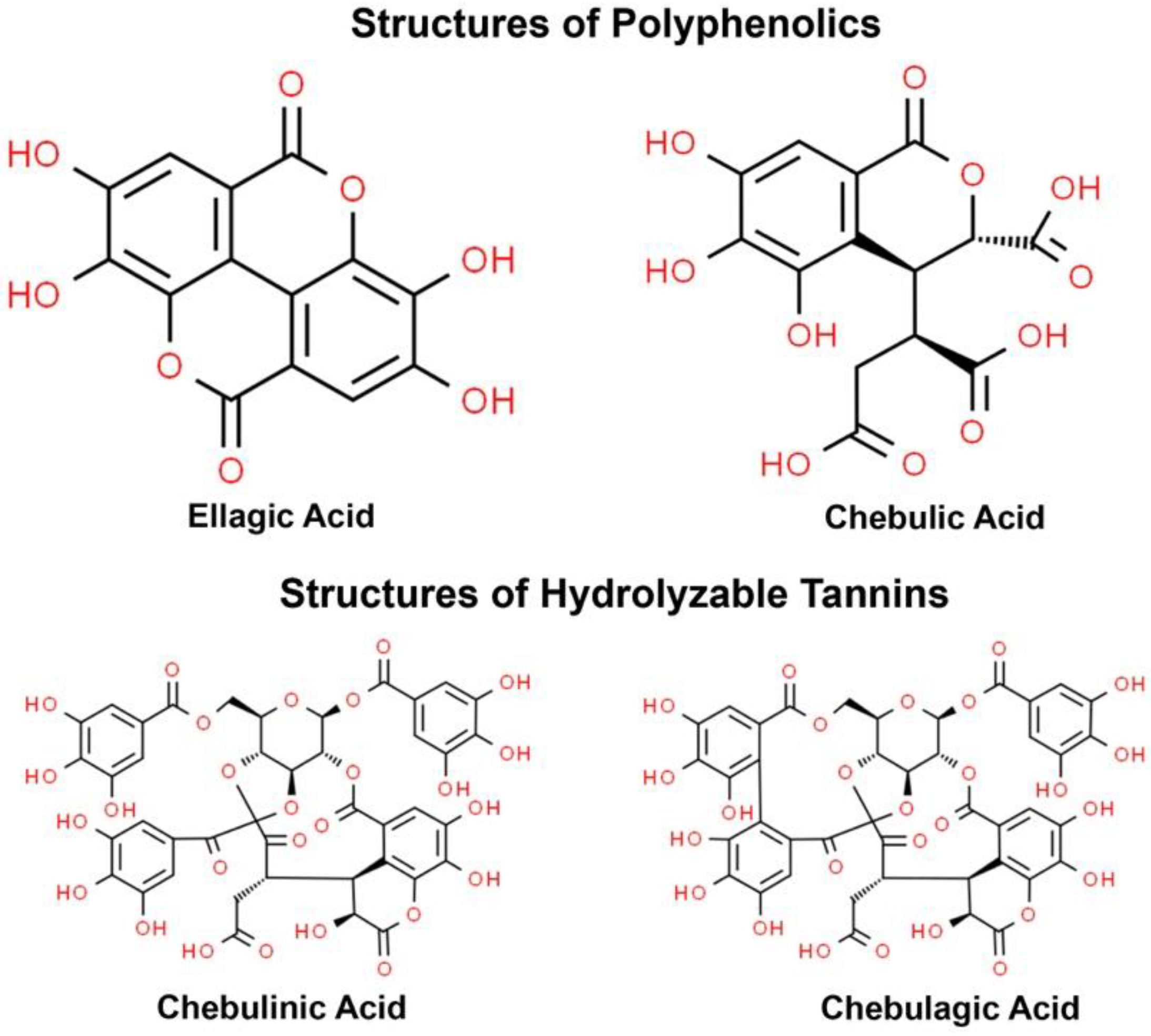
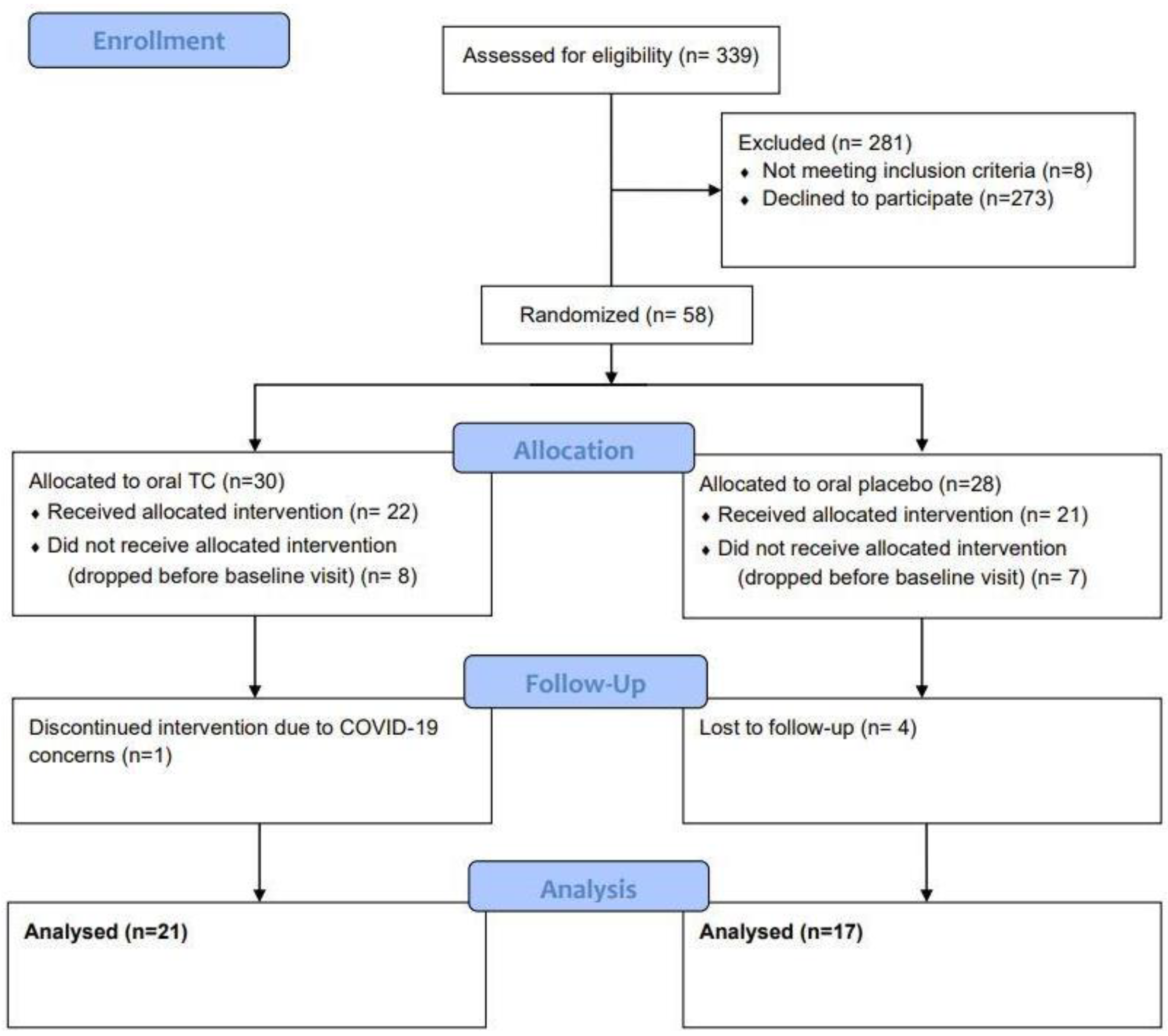
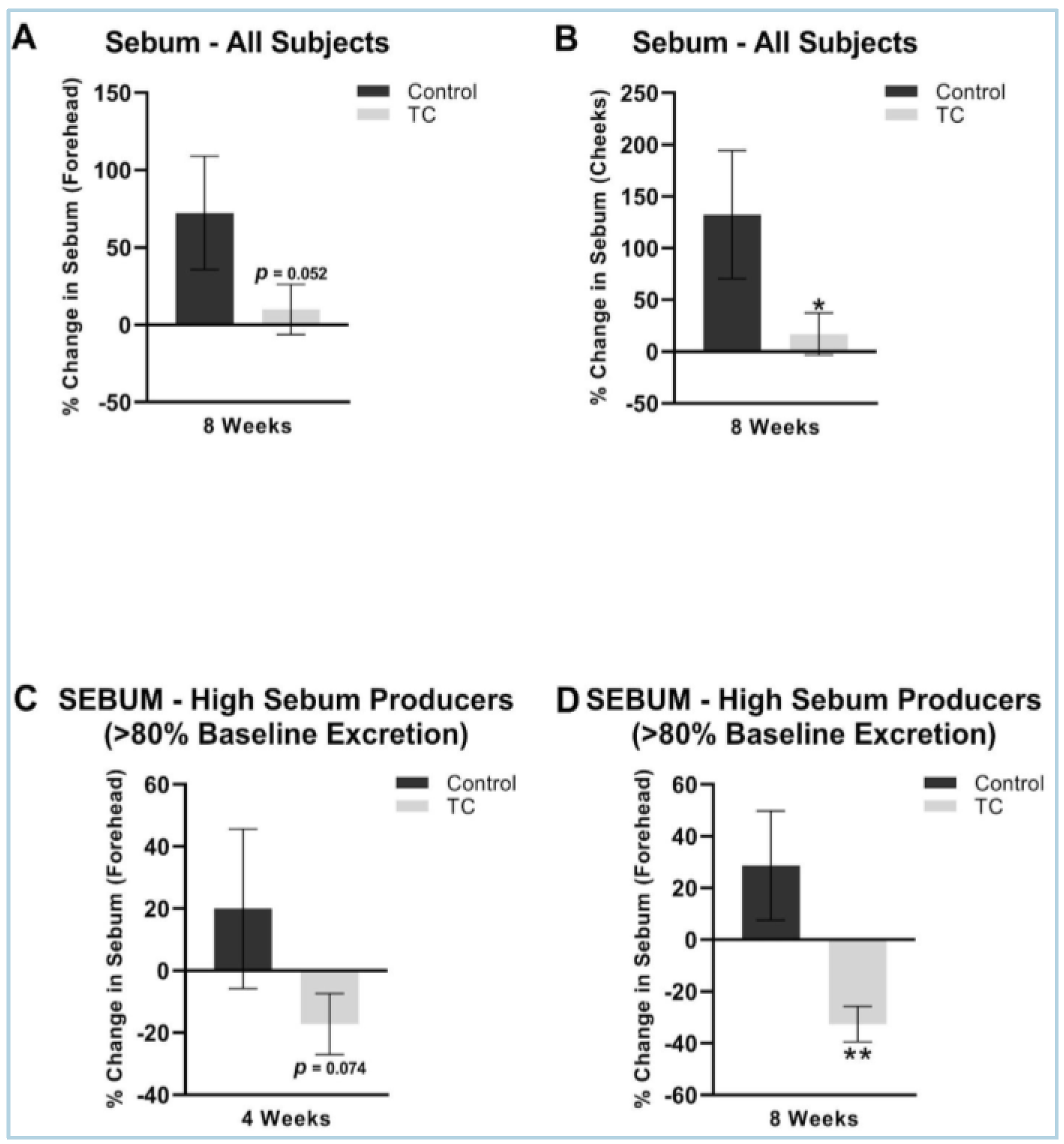
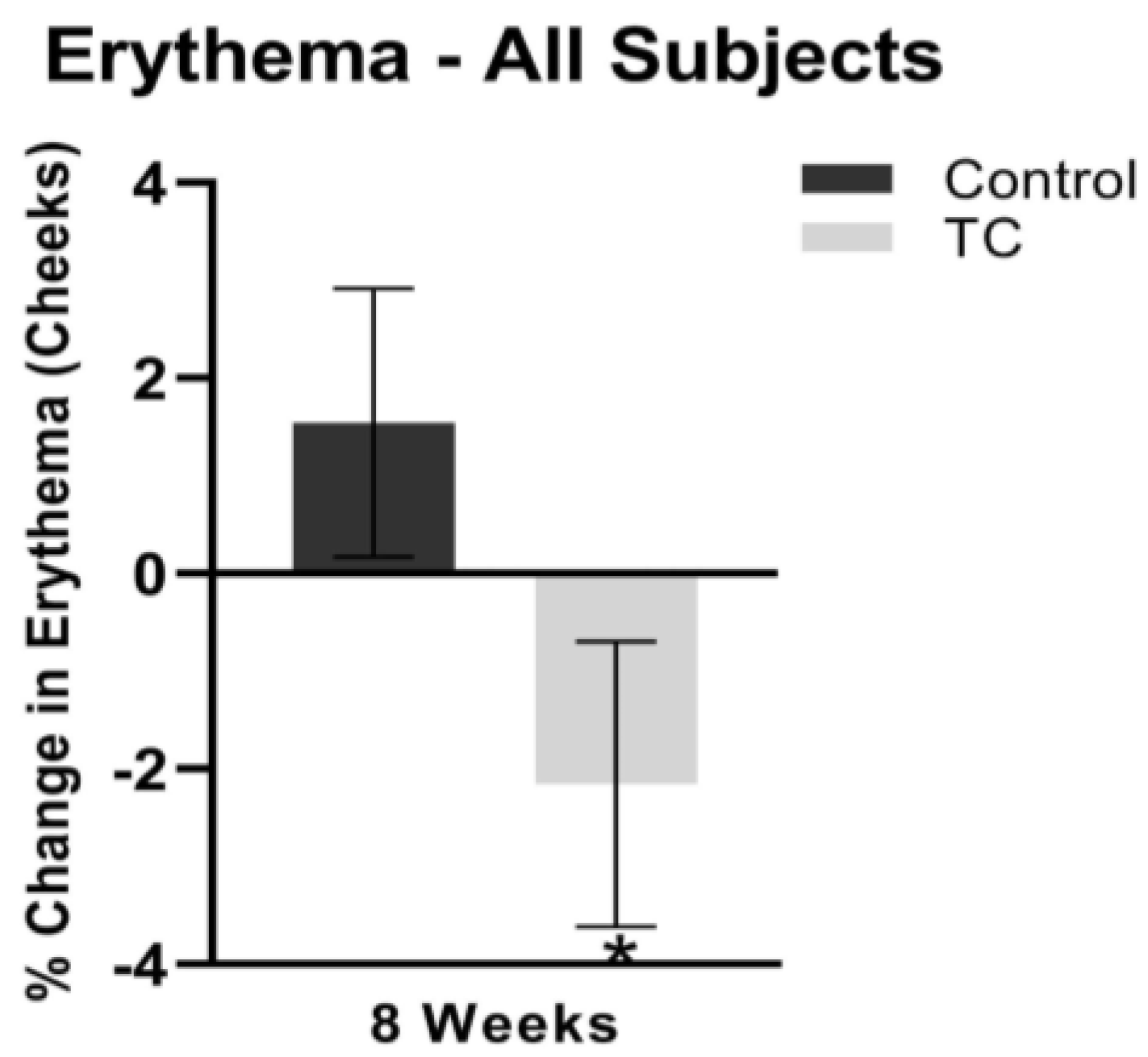
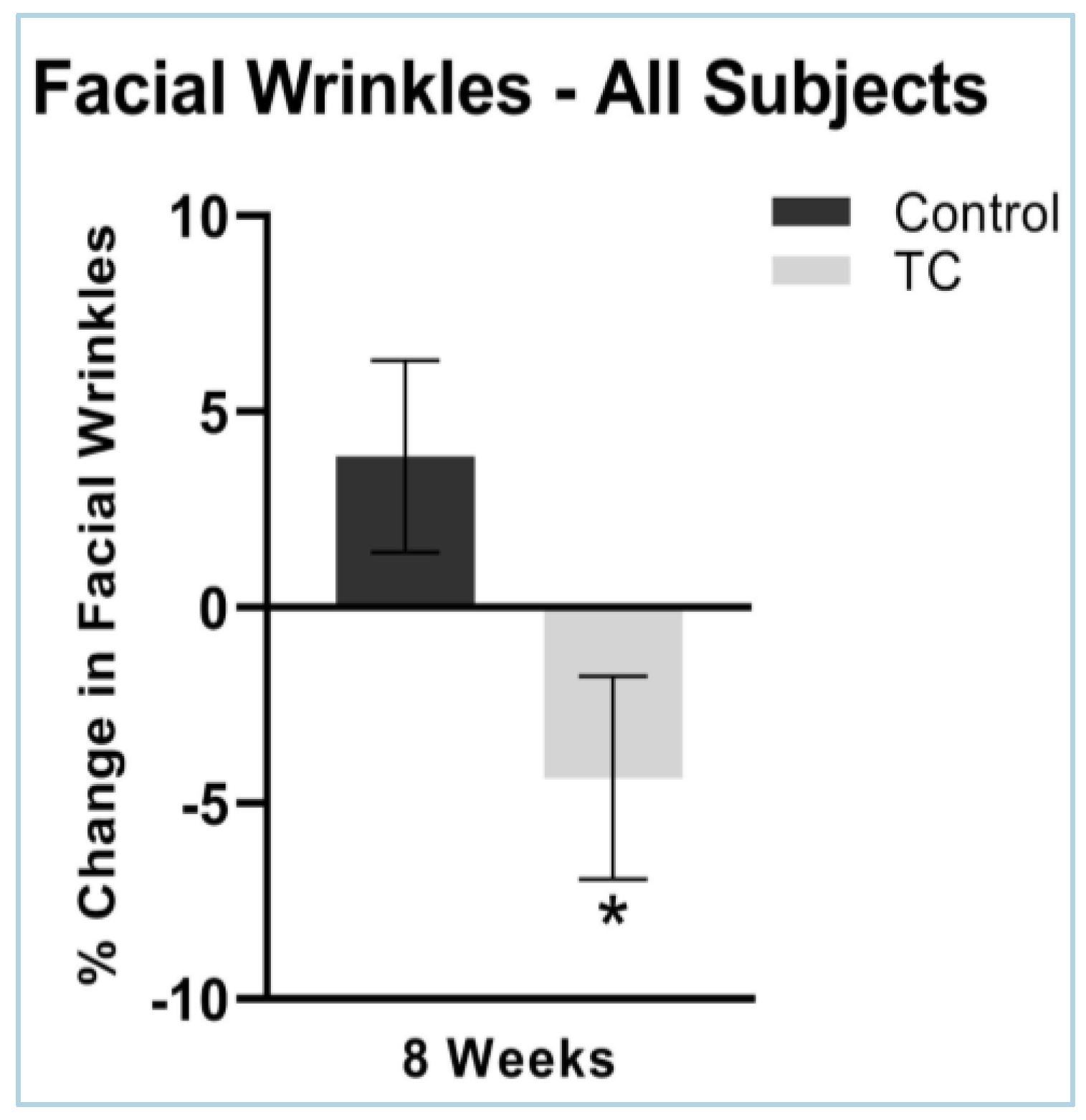
Disclaimer/Publisher’s Note: The statements, opinions and data contained in all publications are solely those of the individual author(s) and contributor(s) and not of MDPI and/or the editor(s). MDPI and/or the editor(s) disclaim responsibility for any injury to people or property resulting from any ideas, methods, instructions or products referred to in the content. |
© 2023 by the authors. Licensee MDPI, Basel, Switzerland. This article is an open access article distributed under the terms and conditions of the Creative Commons Attribution (CC BY) license (https://creativecommons.org/licenses/by/4.0/).
Share and Cite
Chakkalakal, M.; Pan, A.; Nadora, D.; Gahoonia, N.; Chaudhuri, R.K.; Burney, W.; Thacker, S.; Shakhbazova, A.; Subramanyam, C.; Chambers, C.J.; et al. Randomized Double-Blind Placebo-Controlled Supplementation with Standardized Terminalia chebula Fruit Extracts Reduces Facial Sebum Excretion, Erythema, and Wrinkle Severity. J. Clin. Med. 2023, 12, 1591. https://doi.org/10.3390/jcm12041591
Chakkalakal M, Pan A, Nadora D, Gahoonia N, Chaudhuri RK, Burney W, Thacker S, Shakhbazova A, Subramanyam C, Chambers CJ, et al. Randomized Double-Blind Placebo-Controlled Supplementation with Standardized Terminalia chebula Fruit Extracts Reduces Facial Sebum Excretion, Erythema, and Wrinkle Severity. Journal of Clinical Medicine. 2023; 12(4):1591. https://doi.org/10.3390/jcm12041591
Chicago/Turabian StyleChakkalakal, Mincy, Adrianne Pan, Dawnica Nadora, Nimrit Gahoonia, Ratan K. Chaudhuri, Waqas Burney, Shivani Thacker, Anastasia Shakhbazova, Chaitra Subramanyam, Cindy J. Chambers, and et al. 2023. "Randomized Double-Blind Placebo-Controlled Supplementation with Standardized Terminalia chebula Fruit Extracts Reduces Facial Sebum Excretion, Erythema, and Wrinkle Severity" Journal of Clinical Medicine 12, no. 4: 1591. https://doi.org/10.3390/jcm12041591
APA StyleChakkalakal, M., Pan, A., Nadora, D., Gahoonia, N., Chaudhuri, R. K., Burney, W., Thacker, S., Shakhbazova, A., Subramanyam, C., Chambers, C. J., & Sivamani, R. K. (2023). Randomized Double-Blind Placebo-Controlled Supplementation with Standardized Terminalia chebula Fruit Extracts Reduces Facial Sebum Excretion, Erythema, and Wrinkle Severity. Journal of Clinical Medicine, 12(4), 1591. https://doi.org/10.3390/jcm12041591







